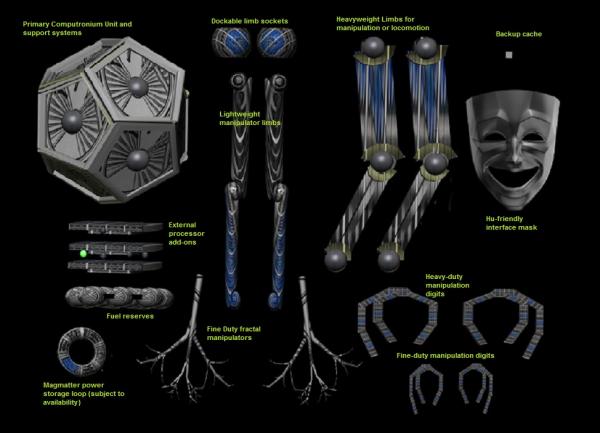BY LETTER
Bespoke Moravec Design
Technology > Application > Augmentics
Technology > Application > Everydaytech
Technology > Application > Robotics
Sophonts > Modosophonts > Vec
Technology > Application > Everydaytech
Technology > Application > Robotics
Sophonts > Modosophonts > Vec
AKA Bespokers | |
 Image from Steve Bowers | |
| Some of the contents of a typical Bespoke dresser | |
Bespoker vecs keep personal or public "dressers" containing a variety of body chassis, technorgans, sensors, limbs and miscellaneous machinery. There is a great diversity in dresser design. The archetypical configuration exists in three parts: the "front end" comprised of an alcove fitted with a plethora of manipulators and tools on extendable arms. This section assembles and disassembles bodies using clamps, welds, microscrews, mechanosynthesis, precise positioning of self-attachment points etc. The "storage section" is generally the largest and consists of a volume of cargo gel into which body parts are efficiently packed. The "back end" features autofabs and other manufacturing equipment for the maintenance, repair and creation of body parts. Communities that prefer public dressers over personal tend to develop rituals (formal or informal) surrounding exchange of body parts between individuals. In some cases this is a quick, casual swap between friends for a specific task and in others it can be part of a ceremony indicating marriage, merging or other social contract. In some societies Bespokers utilise mobile dressers, these resemble omnivehicles and can drive, swim and fly wherever their owner needs them. This is particularly common on large megastructures, like KIyoshi, where long-range travel is frequent.
The advantage of this design approach is to allow vecs to quickly and easily fully customise their body plan for different jobs, scenarios or cultural trends. At the same time the fixed nature of the body parts appeals to those favouring static body forms, as opposed to fully smart matter vecs. Sophonts looking to adopt Bespoker design should take care to ensure their neurotypes are suitably engineered to deal with rapid changes in bodily form. Some vecs engineer their neurotypes so that they can easily form poly-sophont bodies with other sophonts. These groups use dressers to assemble large bodies around multiple brains/ Often physical components will contain computronium allowing them network with other components and synthesis a new body sense/control program for the inhabiting vec. The Emple-Dokcetics are prominent users of this technology, going so far as to modularise their minds as well.
It should be noted that Bespokers are distinct from modubots or other smart matter vecs (who, over the millennia, have largely supplanted the popularity of this design philosophy). The latter inhabit bodies mostly or fully composed of modular smart matter that can reconfigure as needed. Bespoker design instead focuses on body plans comprised of fixed components that can be reconfigured with new components.
Related Articles
Appears in Topics
Development Notes
Text by Ryan B
Initially published on 21 November 2016.
Initially published on 21 November 2016.






